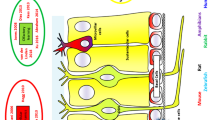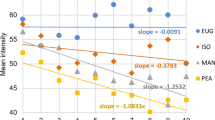Abstract
An analysis of the interaction between stimulus molecules and the olfactory receptor cell membrane is presented. The model is based upon a sequence of events, i.e. stimulus delivery at the olfactory epithelium, absorption of molecules in the mucus layer, diffusion of the molecules towards the receptor cells and molecule-receptor cell membrane interaction. The mathematical analysis considers the situation during electrophysiological experiments, where an odour puff is delivered at an exposed olfactory mucosa. Such a situation resembles sniffing of odour samples. The analysis is discussed in relation to experimental evidence.
Similar content being viewed by others
Literature
Amoore, J. E. 1962. “The Stereochemical Theory of Olfaction”.Proc. Scient. Sect., Toilet Goods Ass. 37 (suppl.), 1–23.
Beidler, L. M. 1971. “Taste Receptor Stimulation with Salts and Acids’. InHandbook of Sensory Physiology Chemical Senses 2, Ed. L. M. Beidler, pp. 200–220. Berlin: Springer.
Bostock, H. 1973. “Diffusion and the Frog E. O. G.”. InTransduction Mechanisms in Chemoreception, Ed. T. M. Poynder, pp. 27–38. London: Information Retrieval Limited.
— and T. M. Poynder. 1972. “Apparatus for Delivering and Monitoring a Sequence of Odour Stimuli”.J. Physiol. Lond. 224, 14–15.
Davies, J. T. 1965. “A Theory of the Quality of Odours”J. theor. Biol. 8, 1–8.
De Simone, J. A. and S. Price. 1976. “A Model for the Stimulation of Taste Receptor Cells by Salt”.Biophys. J. 16, 869.
Drongelen, W. van. 1978. “Unitary Recordings of Near Threshold Responses of Receptor Cells in the Olfactory Mucosa of the Frog”.J. Physiol., Lond. 277, 423–435.
—, A. Holley and K. B. Døving, 1978. “Convergence in the Olfactory System: Quantitative Aspects of Odour Sensitivity”.J. theor. Biol. 71, 39–48.
Gesteland, R. C., J. Y. Lettvin and W. H. Pitts, 1965. “Chemical Transmission in the Nose of the Frog”.J. Physiol. Lond. 182, 525–559.
Getchell, T. V. and M. L. Getchell, 1977. “Early Events in Vertebrate Olfaction”.Chemical Senses Flavor 2, 313–326.
Heck, G. L. and R. P. Erickson, 1973. “A Rate Theory of Gustatory Stimulation”.Behav. Biol. 8, 687–712.
Holley, A., A. Duchamp, M. F. Revial, A. Juge and P. MacLeod 1974. “Qualitative and Quantitative Discrimination in the Frog Olfactory Receptors: Analysis from Electrophysiological Data”.Ann. N. Y. Acad. Sci. 237, 102–114.
— and P. MacLeod, 1977. “Transduction at Codage des Informations Olfactives chez les Vertébrés”.J. Physiol. Paris73, 725–828.
Kaissling, K. E. 1971. “Insect Olfaction”. InHandbook of Sensory Physiology Chemical Senses 1, Ed. L. M. Beidler, pp. 351–431. Berlin: Springer.
Masson, C., S. Kouprach, I. Giachetti and P. MacLeod, 1977. “Relation between Intramembranous Particle Density of Frog Olfactory Cilia and E. O. G. Response”. InOlfaction and Taste 6, Eds J. Le Magnen and P. MacLeod, p. 195. London: Information Retrieval Limited.
Menco, B. P. M. 1977. “A Qualitative and Quantitative Investigation of Olfactory and Nasal Respiratory Mucosal Surfaces of Cow and Sheep Based on Various Ultrastructural and Biochemical Methods”.Commun. Agric. Univ., Wageningen 77, 13–170.
Ottoson, D. 1956. “Analysis of the Electrical Activity of the Olfactory Epithelium”Acta Physiol. Scand. 35, suppl. 122, 1–83.
— 1971. “The Electro-Olfactogram”. InHandbook of Sensory Physiology Chemical Senses 1, Ed. L. M. Beidler, pp. 95–131. Berlin: Springer.
Poynder, T. M. 1973. “Self-shunting and the Frog E. O. G.”. InTransduction Mechanisms in Chemoreception, Ed. T. M. Poynder, pp. 241–250. London: Information Retrieval Limited.
Roberts, G. E. and H. Kaufman, 1966.Table of Laplace Transforms. Philadelphia: W. B. Saunders Co.
Takagi, S. F., G. A. Wyse, H. Kitamura and K. Ito, 1968. “The Roles of Sodium and Potassium Ions in the Generation of the Electro-olfactogram”J. gen Physiol. 51, 552–578.
Wright, R. H. C. Reid and H. G. V. Evans, 1956. “Odour and Molecular Vibration. A New Theory of Olfactory Stimulation”.Chem. Ind. 37, 973–977.
Author information
Authors and Affiliations
Rights and permissions
About this article
Cite this article
van Drongelen, W., Pagnotte, Y. & Hendriks, M.H. Primary events in odour detection. Bltn Mathcal Biology 44, 411–423 (1982). https://doi.org/10.1007/BF02462289
Received:
Revised:
Issue Date:
DOI: https://doi.org/10.1007/BF02462289




